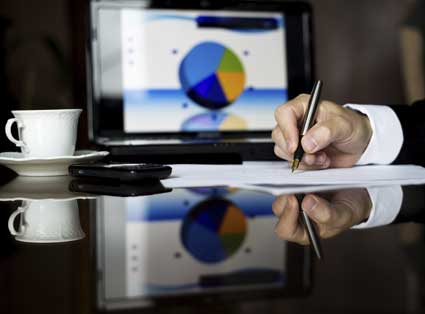Running Reports Showing Progress in MS Project 2013
Reports make it easier to communicate about your project. They make it easier to show the boss exactly how great you are doing. What's more, they show how costs are accumulating, what tasks are in progress, and which ones still need to start. They show progress and give you a picture of each element of the project and the project as a whole.
About Standard Reports
Standard reports are predesigned reports that Project offers you. They offer a lot of choices regarding the information you can add, so at the same time that we say they're predesigned, they're also customizable.
You can choose the format for standard reports, such as a table, chart, or comparison report. Some let you choose the orientation (landscape or portrait). In addition, you can also customize standard reports by changing their name, the periods they cover, the table of information, and the filters. You can also add themes, formatting, images, and shapes to standard reports.
To run a standard report, go to the Report tab.

There are four standard report categories:
-
Dashboard
-
Resources
-
Costs
-
In progress
Each category contains several reports.
Pictured below is the different standard reports for the Resources Category
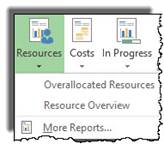
Running a Standard Report
To run a report, first click a report category, as we showed you in the last section.
We are going to choose the Resources Category.
Next, select a report.
We are choosing Resource Overview just to show you how easy it is to run a standard report.
When we click on Resource Overview, the report is generated for us in the Project 2013 window.
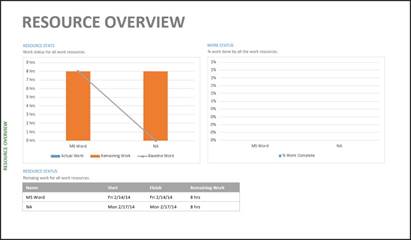
About Dashboard Reports
Dashboard reports are new to Project 2013. There are five dashboard reports:
-
Burndown
-
Cost Overview
-
Project Overview
-
Upcoming Tasks
-
Work Overview
To run a dashboard report, click the Dashboard dropdown arrow (under the Report tab), then select which report you want. We are going to choose Burndown.
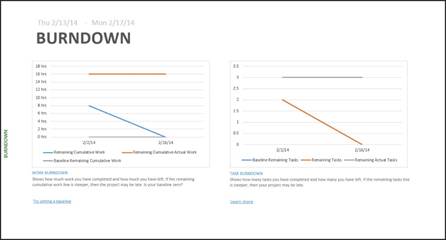
This report is used to compare baseline work remaining to amount of work remaining and the number of tasks remaining compared with baseline tasks remaining. This helps you to see whether you are working at the pace you planned or if you are in danger of falling behind.
Creating a New Report
If you can't find the standard report that covers what you need, you can also create a new report.
To do this, go to Report>New Report.
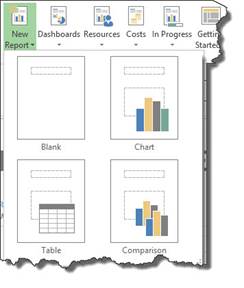
Choose if you want a blank, table, or comparison report.
We are going to choose chart.

Enter a name for the report, then click OK.
You will now see this split window:
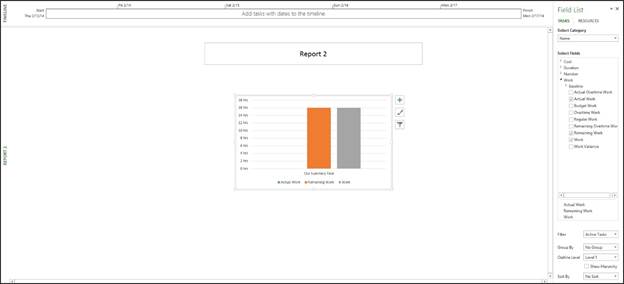
Your report is on the left. On the right, you have a Field List where you can choose fields for your report.
Go to the Select Category section. Here you can choose Time, ID, Name, Resource Names, and Unique ID.

Next, go to the Select Fields category and chose the fields you want in your report by checking the boxes.

You can also apply a filter if you want.

Select grouping from the Group By dropdown menu if you want to group information.
Select a level to view the information. Level 1 is the entire project.
Finally, choose how you want the data sorted. This is the order you want the data presented based on the fields you chose.
You can click Enter to view the report. The report is saved under Custom under the Report tab.
Customizing a Standard Report
As we told you, you can also customize standard reports. There are three categories that you can edit or modify in a standard report.
These three categories are:
- Definition. The definition includes the name of the report, the time period for the report, the table of information, any filters that you've applied, and whether or not you want your summary of tasks to appear.
- Details. You can also include details for tasks such as task notes and predecessors. Details for resource assignments, notes, and cost can also be included. What's more, you can show tools, add a border, or place gridlines between the details of the report.
- Sort. Project allows you to sort by three criteria in ascending or descending order.
Once you create a report in Project 2013, a new tab will appear on the ribbon. This is the Report Tools Design tab, pictured below.

Using the tools in this tab, you can customize your standard report by adding a theme, changing the font, adding effects, etc. You can also add images, shapes, and text box. What's more, you can add page breaks, adjust the margins, and set the orientation or paper size.
These are all tools common to all Microsoft Office products. We can be almost 99.9% sure that if you are using Project 2013, you have also used other Office products and are familiar with these tools.
That said, instead of covering how to use these tools, we are going to cover three important guidelines for customizing and formatting your reports.
1. Unlike with a Word document, you can't add graphics wherever you want. They can only be added to the chart pane of Gantt Chart view, a task note, a resource note, or a header, footer or legend in reports.
2. Data in a chart can be formatted by double clicking on a chart section. When you do this, a Chart Tools Design tab appears and also a Format Plot area pane on the right side.
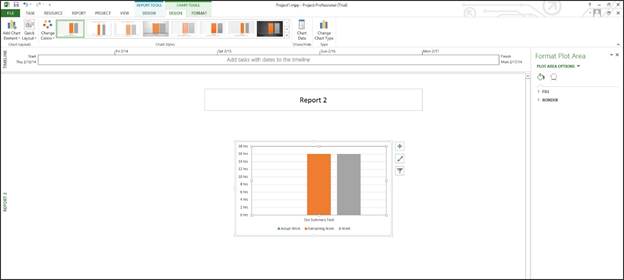
3. Move or resize any item in a report by clicking it, then moving it or resizing it.
Creating Visual Reports
Visual reports are a lot like Pivot tables in Excel. They allow you to view data from different perspectives beyond the standard report capabilities. These perspectives are very useful for data analysis.
Project offers you six categories of Visual reports. Some of these are based on time phased data, or data distributed over time, and some are not. These categories are:
-
Task Usage. This is based on time phased data for tasks and shows you cash flow and earned value over time.
-
Resource Usage. This is based on time phased resource data and shows you resource availability, costs, and work data.
-
Assignment Usage. This is also time phased data that shows baseline versus actual costs and baseline versus actual work.
-
Task Summary, Resource Summary, and Assignment Summary. These provide diagram views of work and cost data. They are not time phased.
Creating a Visual report is easy.
To create and generate a Visual report, go to Report>Visual Reports.
The Visual reports dialogue box now appears, as shown in the next snapshot.
Select if you want the report template created in Excel or Visio.
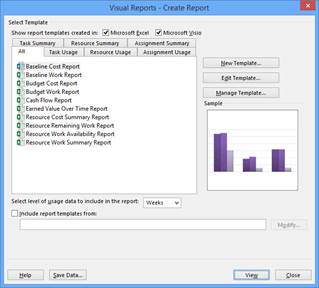
Select the report you want to view.
Click the View button.
Your report will then be generated in either Visio or Excel, depending on which one you chose.
Printing Reports
The first thing you always need to do before you print anything in Project is to view the page setup so you know that all the information you need will be printed on the page.
To modify the page setup for a report, go to File>Print, then click on the Page Setup link, circled in the snapshot below.
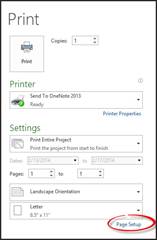
The Page Setup dialogue box is shown in the next snapshot.
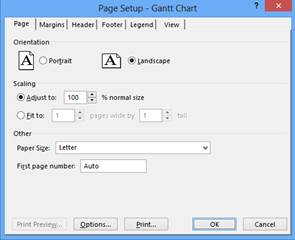
As you can see, there are six tabs in this dialogue box. The Page tab will help you set the paper size, orientation, and scaling.
If you need to adjust your margins, click on the Margin tab. If you need more room for your report to display, you can always reduce margins. You can increase margins if you have a brief report, but do not want to hand out a report that only fills a small part of the page.
If you've used headers and footers in your report, you will find the Headers and Footers tabs helpful.
The Legend tab will help you create a legend to explain the various graphic elements. The legend is automatically created for you. All you have to do is specify the text that goes with the legend.
The View tab allows you to select if you want to print all columns, how many columns per page, print notes, and print blank pages. You can also choose to print column totals. This pertains to the Usage views.
Printing Project Information
You can print any information that you have in your project. This includes the various views. In this article, we are going to do a quick run through of how to print in Project. It is important that you aren't left with any questions.
Before you print, choose exactly what you want to print. The best way to do this is go to the View menu and select what view you want. We are going to select Gantt Chart view.
1. Select how many copies you want to print.
2. Select the printer you want to use. You can click Printer Properties to set the quality of print, etc.
3. Select the settings you want, including the orientation and paper size.
Let's click Page Setup. It is the blue link circled in red in the snapshot above.
The Page Setup dialogue box looks like this:
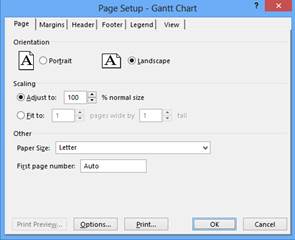
The first tab that you will see in this dialogue box is Page. It is shown by default.
In the first section of the Page tab is Orientation.
-
Portrait means the short edge of the paper is at the top.
-
Landscape means the long edge of the paper is at the top.
Next is Scaling. Select either the Adjust To or Fit To settings.
-
Adjust To is based on a percentage of the actual size.
-
The Fit To allows you to control the scaling.
In the Other section, you get to select paper size and the first page number.
Now, let's click over to the Margins tab.
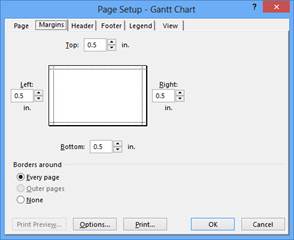
Here is where you can adjust your margins.
The preview in the center shows you how your margins will appear on the page. Use the arrows to set the top, bottom, right, then left margins.
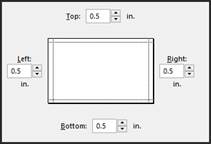
In the Borders Around section, you can select if you want the margins to appear as borders around your page.
Next, let's click over to the Header tab.
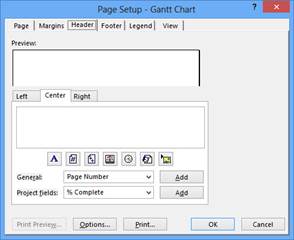
The Preview section shows you a preview of your headers as they appear now.
The Alignment section allows you to align your headers. As you can see, there are tabs for Left, Center, and Right.

You can use the buttons below the Alignment section to further format your text.

Now, let's click on the Footer tab.
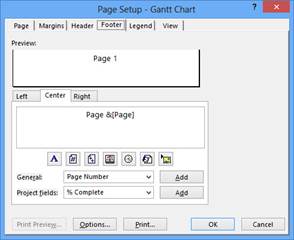
The Footer tab offers you the same options, except they are for your footers.
The Legend tab allows you to add a legend to whatever you are printing
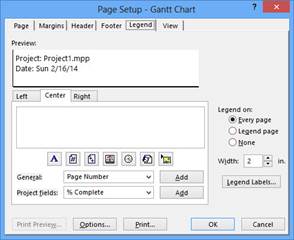
The options for the legend are pretty self-explanatory. However, it is important to note that Project creates the legend for you. All you have to do is add text.
The View tab is pictured below.
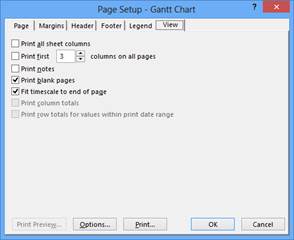
This area allows you to select if you want to print all columns, how many columns per page, print notes, and print blank pages. You can also choose to print column totals. This pertains to the Usage views.
When you have your page setup, click OK to save your options.
When you go to File>Print, the Print Preview is on the right side of the window.
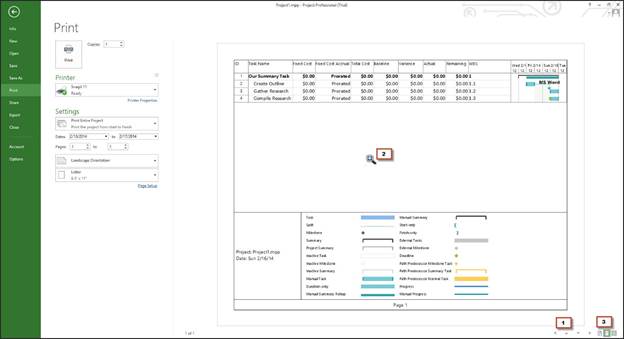
From this screen, you can return to Page Setup, print, or close it and go back to working on your project.
1. You can also use the arrows to move around the report
2. You can zoom in to get a closer view. The magnifying glass automatically appears when you mouseover it. Just click to zoom in.
3. You can look at a single page or multiple pages by clicking the appropriate button
When you have adjusted all your print settings and are ready to print, set the number of copies you want to print, then click the Print button.



















